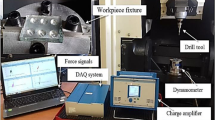Abstract
Burr size at the exit of the holes in drilling is a quality index and hence it becomes essential to predict the size of the burr formed in order to cater to the demand of product quality and functionability. In this paper, artificial neural network (ANN)-based models have been developed to study the effect of process parameters such as cutting speed, feed, drill diameter, point angle, and lip clearance angle on burr height and burr thickness during drilling of AISI 316L stainless steel. A multilayer feed-forward ANN; trained using error back-propagation training algorithm (EBPTA) has been employed for this purpose. The input-output patterns required for training are obtained from drilling experimentation planned through Box-Behnken design. The simulation results demonstrate the effectiveness of ANN models to analyze the effects of drilling process parameters on burr size.
Similar content being viewed by others
References
Koelsch J (2001) Divining edge quality by reading the burrs. Qual Magaz 3:24–28
Gillespie LK (1979) Deburring precision miniature parts. Precis Eng 1(4):189–198
Gillespie LK (1975) Burrs produced by drilling. Bendix Corporation, Unclassified Topical Report, BDX-613-1248
Gillespie LK, Blotter PT (1976) The formation and properties of machining burrs. ASME J Eng Ind 98(2):66–74
Sugawara A, Inagaki K (1982) Effect of workpiece structure on burr formation in micro drilling. Precis Eng 4(1):9–14
Pande SS, Relekar HP (1986) Investigations on reducing burr formation in drilling. Int J Mach Tool Des Res 26(3):339–348
Stein JM, Dornfeld DA (1997) Burr formation in drilling miniature holes. Ann CIRP 46(1):63–66
Kim J, Dornfeld DA, Furness R (1999) Experimental study of burr formation in drilling of intersection holes with gun and twist drills. Trans NAMRI/SME 27:39–44
Dornfeld DA, Kim J, Dechow H, Hewson J, Chen LJ (1999) Drilling burr formation in titanium alloy, Ti-6Al-4V. Ann CIRP 48(1):73–76
Min S, Dornfeld DA, Nakao Y (2003) Influence of exit surface angle on drilling burr formation. ASME J Manuf Sci Eng 125(4):637–644
Ko SL, Chang JE, Kalpakjian S (2003) Development of drill geometry for burr minimization in drilling. Ann CIRP 52(1):45–48
Guo YB, Dornfeld DA (1998) Finite element analysis of drilling burr minimization with a backup material. Trans NAMRI/SME 26:207–212
Guo YB, Dornfeld DA (2000) Finite element modeling of drilling burr formation process in drilling 304 stainless steel. ASME J Manuf Sci Eng 122(4):612–619
Min S, Dornfeld DA, Kim J, Shyu B (2001) Finite element modeling of burr formation in metal cutting. Mach Sci Technol 5(3):307–322
Min S, Kim J, Dornfeld DA (2001) Development of a drilling burr control chart for low alloy steel, AISI 4118. J. Mater Process Technol 113:4–9
Kim J, Dornfeld DA (2000) Development of a drilling burr control chart for stainless steel. Trans NAMRI/SME 28:317–322
Kim J, Min S, Dornfeld DA (2001) Optimization and control of drilling burr formation of AISI 304L and AISI 4118 based on drilling burr control charts. Int J Mach Tools Manuf 41:923–936
Lee SS, Chen JC (2003) On-line surface recognition system using artificial neural networks system in turning operations. Int J Adv Manuf Technol 22:498–509
Ozecelik B, Okem H, Kurtaran H (2005) Optimum surface roughness in end milling Inconel 718 by coupling neural network model and genetic algorithm. Int J Adv Manuf Technol 27:234–241
Sarkar S, Mitra S, Bhattacharyya B (2006) Parametric optimization of wire electrical discharge machining of γ titanium aluminide alloy through an artificial neural network model. Int J Adv Manuf Technol 27:500–508
Sanjay C, Jyothi C (2006) A study of surface roughness in drilling using mathematical analysis and neural networks. Int J Adv Manuf Technol 29:846–852
Karri V, Kiatcharoenpol T (2002) Prediction of internal surface roughness in drilling using three feed-forward neural networks - a comparison. In: Proc 9th International Conference on Neural Information Processing (ICONIP’O2), Vol 4, pp 1890–1894
Sanjay C, Neema ML, Chin CW (2005) Modeling of tool wear in drilling by statistical analysis and artificial neural network. J Mater Process Technol 170:494–500
Singh AK, Panda SS, Chakraborty D, Pal SK (2006) Predicting drill wear using an artificial neural network. Int J Adv Manuf Technol 28:456–462
Kosko B (1994) Neural networks and fuzzy systems. Prentice-Hall of India, New Delhi
Schalkoff RB (1997) Artificial neural networks. McGraw-Hill International Edition, New York
Box GEP, Behnken DW (1960) Some new three level designs for the study of quantitative variables. Technometrics 2:455–475
Montgomery DC (2001) Design and analysis of experiments. Wiley, New York
Gaitonde VN, Karnik SR, Achyutha BT, Siddeswarappa B (2007) Methodology of Taguchi optimization for multi-objective drilling problem to minimize burr size. Int J Adv Manuf Technol 34:1–8
Stein JM (1997) The burrs from drilling: an introduction to drilling burr technology. Burr Technology Information Series™, USA
Math Works Incorporation (2005) MATLAB user manual version 7.1 R14, Math Works Incorporation, Natick, MA
Author information
Authors and Affiliations
Corresponding author
Rights and permissions
About this article
Cite this article
Karnik, S.R., Gaitonde, V.N. Development of artificial neural network models to study the effect of process parameters on burr size in drilling. Int J Adv Manuf Technol 39, 439–453 (2008). https://doi.org/10.1007/s00170-007-1231-5
Received:
Accepted:
Published:
Issue Date:
DOI: https://doi.org/10.1007/s00170-007-1231-5




